
Common Digital Marketing Terms And Definitions Updated May 9th, 2022
I remember when I first started online I didn’t know what a lot of terms used in digital marketing meant.
And that got me thinking, that things haven’t changed. There are all kinds of terms that new online marketers don’t know and new terms are being used all the time.
So I thought putting a list of digital marketing terms and definitions together would be a good idea.
So, here’s my list of 129 common digital marketing terms and definitions to help you out. I’ve put them in alphabetical order to make searching for things easier.
I will be adding more terms to this list. But of course, if there is a term you think I should add to this list please let me know. You can either email me or leave your suggestion in the comment section below.
1) 301 Redirect
A 301 redirect is used for permanent redirects when you want to redirect (move) people from one webpage to another webpage on your website. Or redirect people from one website to another website.
Think of a 301 redirect like a forwarding address you would set up with the post office when you move. By setting up a 301 redirect you avoid creating 404 errors. You’re also telling the search engines you know that content is listed in the SERPs. Well, it’s now located here.
By doing this anyone that clicks the old URL associated with that page/post or website will automatically be redirected to the new URL. And this happens so fast that no one will notice the redirect.
2) 302 Redirect
302 redirects are like 301 redirects. The only difference is a 301 redirect is for temporary situations. You only want to use a 302 redirect if you plan on bringing the old page back.
3) 404 Error
Have you clicked on a link and you get an oops message. Some like “Sorry the page you’re looking for is not here”. That’s a 404 error. Someone deleted or moved the page on their website. What they should have done is created a 301 redirect.
4) Above The Fold
This is a website term that refers to the content a visitor to your website can see before scrolling down on any page on your website.
Knowing what’s above the fold is very important when you’re creating things like a landing page (opt-in) for inbound marketing.
5) A/B Testing
The best way to improve your marketing is by conducting A/B testing. This is when you compare two variations of the same variable to see which one performs better.
These variables can be anything. Such as the headline, color, call to action, copy, etc.
6) Ad Network
An ad network brings together businesses that what to run ads on websites that what to display them. The ad network itself is neutral, they are just the middle man.
For example, Google Display Network is an ad network.
7) AdWords
Adwords is Google’s PPC (pay per click) program. This is where you bid to have your ad placed within Google’s search results.
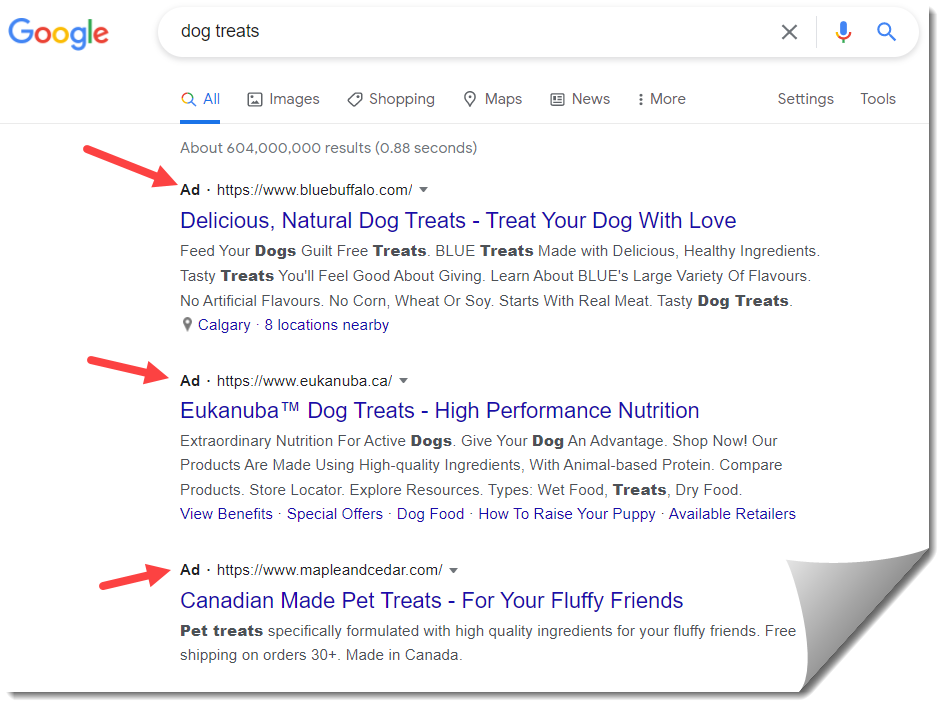
8) Affiliate Marketing
Affiliate marketing is performance-based marketing. And as an affiliate marketer, you’ll earn a commission every time someone purchases a company’s product or service that you’re promoting through your own marketing efforts.
In fact, affiliate marketing is how I earn a full-time online income and have been doing so since 2005.
9) Affiliate Network
An affiliate network acts as an intermediary between affiliates, and a merchant’s affiliate program.
You can find hundreds of affiliate programs from all different types of companies all in one place. Commission junction (cj.com) ClickBank.com, Shareasale.com, and Linkshare.com are just a handful of affiliate networks.
10) AIDA (Attention, Interest, Desire, Action)
This is the 4 step process found in a sales funnel, that moves people from attention to action (buying).
11) Algorithm
When it comes to a computer an algorithm is a set of rules that the computer follows. When referring to digital marketing – the algorithm is referring to the process in which Google uses to determine the ranking of your website within its search results.
And when it comes to Google performing an algorithm update, they like using nicknames such as Panda, Penguin, and Hummingbird.
Each year Google does hundreds of updates to its algorithm but typically it’s only the big algorithm changes that can affect your website’s ranking that is announced to the public.
12) ALT Tag
The alt tag is the text that is used to describe an image or video in words, which provides a text description for search engines. This is a best practice for search engine optimization.
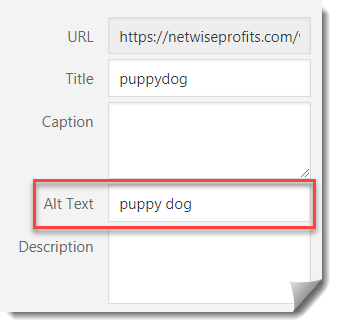
13) Anchor Text
Anchor text is clickable words that have a hyperlink. Typically, these are in blue and are underlined. They are also referred to as a “hypertext link” Here’s an anchor text link. Free Affiliate Marketing Training.
14) API
API stands for Application Program Interface.
An API is a way of getting specific information from other applications or websites. And you can use API for a variety of different needs.
For example, when you’re using an application on your mobile phone the API connects to the internet and then sends the data to the server.
15) Autoresponder
An autoresponder is a program that delivers a series of automated email messages. Companies such as Aweber provide this service.
16) Avatar
This is an image that people attached to their profile, most often to social media profiles. Your avatar does not have to be your image it can also be an icon.
17) Backlink
A backlink is when one website links to another website. So, for if you create a link on your website that goes to another website.
That’s considered a backlink that favors the website you linked to. And vice versa. If someone links to your website from their website that’s a backlink that favors your website.
And by having strong/relevant backlinks from other websites – this is going to help your site rank better in the search engines.
Having relevant backlinks is a major SEO signal when it comes to Google’s algorithm. It tells Google that other websites think of your site as an authority site. And because of that Google rewards your site with better search rankings.
18) B2B
B2B stands for Business to Business.
And as the name suggests it means that you’re marketing products and services to other businesses.
19) B2C
B2C stands for Business to Consumer (customers).
This refers to the tactics that a company would use to sell its products and/or services to people.
20) Bing Ads
Bing is owned by Microsoft, which operates Yahoo! search. And just like Google’s AdWords, this is Bings PPC (pay per click) ad network. As an advertiser, you create an ad and then bid on having your ad placed within the Bing search network.
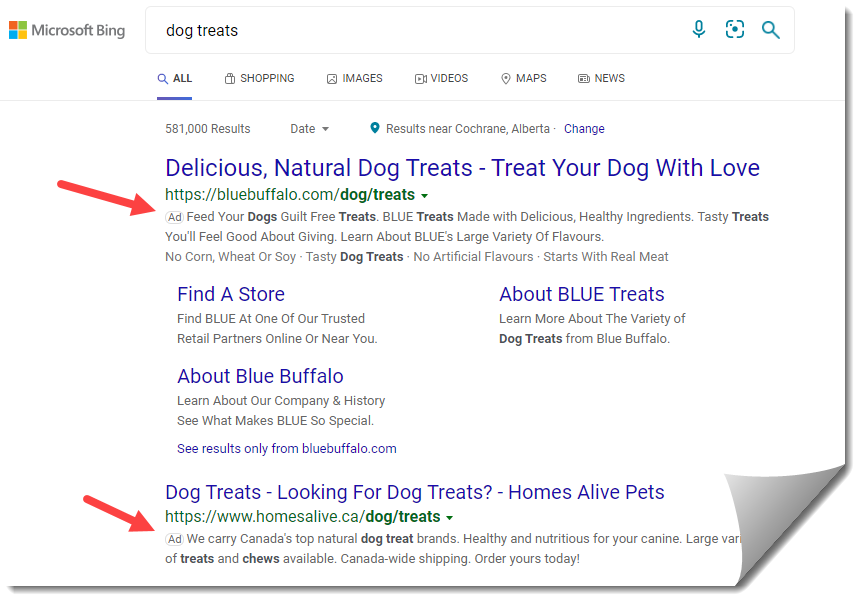
21) Black Hat
This is a slang term used when people use unethical methods to rank a website. Black hat methods are temporary and most sites get delisted or remove from the search results once it’s been discovered black hat methods have been used.
22) Blog
Blog is short for “Web Log”. A blog is a website that is constantly updated with new content. My site is a blog. And a blog is an essential part of becoming a successful digital marketer.
23) BoFu
BoFu stands for Bottom Of The Funnel. And this is the last stage in a sales funnel and this is where a customer is at the buying stage.
24) Bookmark
This is a saved shortcut so you can find things faster. Usually done through your web browser.
25) Bounce Rate
This is the percentage of people that come to your website but do not go to any other pages on your site and just leave, they “bounce”.
26) Bot
A bot usually refers to a “search bot”. Also, known as a search spider. This is software used by search engines to compile and gather information from the internet.
27) Brand Awareness
Brand awareness refers to the extent that which a consumer recalls or recognizes the brand of a company’s related products.
28) Brand Loyalty
Brand loyalty is the positive associate and devotion a consumer has to a particular brand. For example, if you love Coke – your brand loyalty is to Coke over other soft drinks.
29) Bread Crumbs
Bread crumbs is the text path you find at the top of a webpage. Allowing your visitor to know where they are on your website. This helps your visitor to better navigate your website.
Here’s an example of a bread crumb Home > Tools > Specific Tool.
30) Cache
Cache is referring to your browser cache. These are the saved files and data, such as images. These files are stored files so future requests for the same files or data can be retrieved (served) faster.
31) CDN
This stands for Content Delivery System.
This is a geographically distributed network of proxy servers and data centers. And the function of the CDN is to help reduce the latency (load time) of a website.
When using a CDN, when someone comes to your website the information regarding your website is going to be served from the closest server to that end user. Thus increasing the speed at which your content is delivered.
32) Churn Rate
This is a term used in email marketing and for people that have membership sites. It’s the number of subscribers an email loses or the number of members a membership loses in a given period of time, typically for a month. And this number is used to determine the growth rate.
33) CMP
CMP stands for Cloud Management Platform
This is a group of products that can be used to help monitor cloud computing resources.
34) Compression
Compression refers to compressing a file to make it smaller in size. The best example is having compressed image files, so they can be downloaded faster.
35) Cookie
A cookie or “web cookie” is a piece or pieces of information stored as text strings on your computer. These are created when a web server sends a “cookie” to you and then stores it on your browser.
So now the next time you reference this page the browser returns the cookie to the server allowing the server to recall the exact page faster. Cookies are not harmful to your computer.
36) Contact Form
This is a page on a website where a visitor fills in fillable form fields including at a minimum your name and email address so you can contact the website owner. You can see what my contact form looks like on this website by clicking here.
37) Content
Content is any form of published material on the internet.
38) Content Upgrade
A content upgrade refers to providing bonus content in exchange for someone’s email address.
39) Conversion Rate
This is the percentage of how many people complete an action or goal. So, for example, you have an optin page on your site to gather email addresses. So, if half the people that come to this page optin, you have a 50% conversion rate.
40) CPA
Cost Per Acquisition. Also known as Cost Per Action.
CPA is a pricing model where the advertiser will pay for a specific acquisition. This can be as simple as filling in a form or a click or a sale. This is performance-based advertising and typically this is done with paid advertising methods by the marketer
41) CPC
CPC stands for Cost Per Click.
This is where an advertiser pays for each click for an online ad.
42) CPM
CPM stands for Cost Per Thousand.
This is a pricing model for paid advertising. So, this is paid advertising that is going to change you per 1000. So, for example, it could be 1000 banner impressions, it could be per 1000 email subscribers, etc.
43) CSS
CSS stands for Cascading Style Sheets. This is the code used to define the look as well as the functionality of the website.
44) CTA
CTA stands for Call To Action
This is an element found on a website prompting your visitor to take action. It could be a button, an image, or a text link. Here’s a call to action button I use within my review of wealthy affiliate.
45) CTR
CTR stands for Click Through Rate.
This is how many people out of 100 have clicked through a link. So, if you have a 25% clickthrough rate, it means 25 people out of every 100 people are clicking through on your link.
46) Customer Acquisition Cost
CAC is the amount of money it takes to convert a person into a customer. Knowing this number allows you to determine how much money you’ll need to spend to acquire a certain number of customers.
47) Customer Purchase Lifecycle
The customer’s purchase lifecycle is the stage you have in relation to a potential customer. Common customer purchase lifecycles phases are. The Research phase, the Decision phase, and the Action phase (purchasing).
48) Customer Lifetime Value (CLV)
The CLV refers to the predicted profit attributed to a customer’s entire relationship with a company.
49) Customer Pain Point
A customer’s pain point refers to a specific problem or challenges a consumer is experiencing. There are many types of pain points such as financial and health just to name a few.
50) Dark Web
The dark web is a part of the Internet that’s not indexed by search engines and can only be accessed with special software. The dark Webb is typically used for illicit and illegal activities.
51) Domain
The domain is the homepage address of a website. For example, https.netwiseprofits.com is my domain address.
52) Digital Marketing
This is a catchall term when it comes to online marketing such as SEO, PPC, Email Marketing, Affiliate Marketing, Blogging, and Content Marketing. Or any other form of online advertising.
53) Display Network
A display network refers to a network of websites and apps that allows marketers to display ads on their pages. An example of a display network would be Google AdSense.
54) DNS
DNS stands for Domain Name System.
And basically, it’s the phonebook of the internet. Each website is given an IP address (internet protocol), which is a string of numbers.
Each website is connected by each unique IP address. The DNS is a protocol that translates that string of numbers into a domain name (URL). And the reason it does is that it’s a lot easier for people to remember a domain name than a string of numbers.
So, we as people see the internet as domain names. The computers see the internet as numbers.
55) E-Commerce
E-Commerce is electronic commerce. And an e-commerce business is an online retail business that sells products directly to the consumer.
56) Email List
This is a collection of email addresses that can then be sent to targeted email marketing campaigns.
57) Email Marketing
Email marketing refers to using email to convert people on your mailing list into customers.
58) Email List Segmentation
Email segmentation is a marketing technique that segments or splits up an email list. And by doing this you can send more relevant emails to the people on that segmented list.
59) Engagement Rate
The engagement rate is the rate at which followers/visitors engage with your content (posts). Engagement can be comments, social shares, Likes, etc.
60) Event Tracking
Event tracking is used when you want to look beyond revenue and the conversion matrix. For example, using Facebook’s pixel helps you track your customer’s journey by analyzing certain behaviors.
And by doing this you can adjust your marketing to help motivate your visitors to take a particular action. And that action could be anything from filling out a form, playing a video, clicking on a link, or downloading some content.
61) Evergreen Content
Unlike time-sensitive content that is only relevant for a certain period of time.
Evergreen content is content that’s always relevant to your audience no matter when they visit your site and read that content. Evergreen content provides value to your visitor well beyond its publish date.
62) External Link
An external link is a link on a website that links out or off to a different location on the internet.
63) Exit Rate
The exit rate refers to the percentage of visitors to a page on your site and those who leave that page to go to another website.
64) Facebook Live
This is a feature that’s available on Facebook where the user can live stream (broadcast) from their smartphone.
65) Facebook Ads Manager
The Facebook ads manager is the tool that marketers use to create and optimize Facebook ads.
66) Facebook Advertising
This is Facebook’s paid advertising network. Here advertisers can market their brand, service, or product to the Facebook community.
67) Feature Snippets
Featured snippets is a piece of information that’s been pulled from a website by Google and placed within their search results. And you’ll find a featured snippet at the top of the search results within Google.
68) Firewall
A firewall is a software program that protects harmful and potentially malicious traffic that tries to get to your computer over the Internet. Programs such as Norton AntiVirus and AVG are security programs that have firewalls.
69) FTP
FTP stands for File Transfer Protocol.
This is the method used to transfer files between computers over the internet. FileZilla is a free FTP program you can use for this.
70) GIF
GIF stands for Graphics Interchange Format and it refers to the file format for an image. This file format can support both static and animated images.
71) Google Ads
Google ads is an online paid advertising program offered by Google. To advertise you would bid to display your ad which would then be displayed within Google’s search page results.
72) Google Analytics
Google analytics is a free program software program that is used to gather data regarding your website. With this data, you can analyze every aspect of the traffic (visitors) that come to your website. And then use that data to help build and grow your online business.
73) Google Search Console
The Google Search Console is a free tool provided by Google which allows you to check the indexing status and optimize the visibility of your website(s). The google search console does not measure website traffic.
74) Hard Bounce
A hardbound simply refers to any email that was not delivered. And these hard bounces can happen for a variety of reasons.
Such as, it being the wrong or active email address. Maybe the recipient has blocked you from sending them emails. Or even reported your emails as spam, etc.
75) Host
The Host is also referred to as a webhost or service provider. These are companies that provide services that websites need to be to be viewed on the internet. Hostgator and GoDaddy are host providers.
76) HTML
HTML stands for HyperText Markup Language.
This is the code used to create web pages. Just a note, it’s not a real coding language like C++ because it does not use variables.
77) HTTP/HTTPS
HTTP is an acronym for HyperText Protocol and HTTPS means this is a secure connection via Hyper Text Protocol. This is how information is passed from server to server.
HTTPS is now the protocol you want for your website. In fact, if you don’t have the HTTPS protocol it will hurt your efforts to rank your website high in the SERPS (search engine results page) because your website will be seen as insecure.
78) Hyperlink
This is a link that a user can use to move from website to website across the internet.
79) Inbound Link
This is a link that comes from another website that points to your site’s homepage or another specific page or post on your website.
80) Inbound Marketing
Inbound marketing is activities that are used by marketers to bring people to their website with the goal of converting them into customers right away or over time.
81) Index Page
This referrers to your website’s homepage.
82) IP Address
IP stands for Internet Protocol.
Your IP address is a string of numbers separated by periods and it identifies where a computer is anywhere in the world. To find your IP address type in “what’s my IP address” into Google and it will show you.
83) Internal Link
An internal link is a link on a website that links to another location on the same website.
84) Impressions
This term is used in advertising and means how many times an ad has been seen (shown).
85) ISP
ISP stands for Internet Service Provider. This is the company that provides you with access to the internet.
86) JPEG
JPEG stands for Joint Photographic Experts Group.
This image file format is commonly used by digital cameras to store photos and also supports different levels of compression, which makes it great for web graphics.
87) Keyword
This is a word or phrase people use to do a search using a search engine. The common use of keywords is to optimize a page or post to a specific keyword or keyword phrase, so it appears in the search engine results.
For example, if you have optimized a post to the keyword “snowman” your post would show up in the search results for the word “snowman”.
88) Keyword Stuffing
Keyword stuffing is when you repeat the same phrases or words with the goal of trying to manipulate a page’s rank in the search engines.
Now, the search engines have gotten a lot smarter and keyword stuffing doesn’t work anymore. In fact, it actually hurts the ranking of that page and your overall website.
Here’s an example on Google’s developer’s website of what keyword stuffing looks like.

89) Landing Page
A landing page is used for the purpose of gathering email addresses so a marketer can build up their email list and then market to that email list.
This page is designed in such a way that when the person who “lands” on the page has only 2 options. Provide their contact information or leave the page.
Sometimes these pages are also referred to as Squeeze pages. Because you’re squeezing someone’s contact information out of them.
90) Lead Magnet
This is a free gift such as a report, course, software, coupon, resource, etc., used to entice someone to sign up to your email list.
91) Lifetime Value
Lifetime value or LTV. Simply refers to the total worth a customer brings to your business during their lifetime. In other words, it shows you the total revenue your business can expect from every single customer that you have.
92) Link Bait
Linkbait is the process of creating such great content that people will want to link to it.
And the sole purpose of creating link bait is so you can create backlinks to your website.
And the more backlinks you have pointing toward your site helps increase the authority of your site as well as the overall ranking of your content and website within the search engine rankings.
93) Link Building
This is the act of increasing the number of outside links that link back to your website. This is known as a Backlink.
94) Meta Description
A meta description summarizes the contents of your page in 160 characters or less. And is what’s seen in the search engine search results.
95) MoFu
MoFu stands for Middle Of The Funnel. At this point in a sales funnel people have defined their problem but they are still narrowing down their options when it comes to a solution.
96) Native Advertising
Native advertising is popular on social media. And this is advertising that follows the form, feel, and function of the content on the media where it’s placed.
And the advantage of using native advertising is it allows a marketer to target audiences within the content.
97) Niche
A niche is a targeted audience within a market. For example; weight loss is a market. Men over 50 wanting to lose weight is a niche within the weight loss market.
98) Organic Traffic
This is traffic that comes from unpaid sources. It’s free traffic. When the term organic traffic is used it’s typically referring to traffic that comes from search engines like Google, Yahoo, or Bing.
99) Off-Page Optimization
Off-page optimization is everything you do to improve your website’s organic search rankings that do not involve your website. Creating Guest Postings and using Social Media are examples of off-page optimization.
100) On-Page Optimization
On-page optimization refers to everything you do on your website to improve your organic search engine rankings. Optimizing meta tags, descriptions and content are examples of on-page optimization.
101) Page Experience
Pag experience is a set of signals used by Google to determine the experience a visitor has with a webpage (site) beyond its informational value and uses this information as one of the metrics as one of the many ranking signals Google uses.
102) Page Speed
Page speed is the measurement of how fast your page (content) loads. This is also referred to as “page load time”. And the faster the better.
103) Page Rank
Page rank is the placement of a page within the search engine search results. And this rank is based on an algorithm Google uses to determine the backlink links coming to a website.
104) Optin
An optin or “opting in” is referred to a person that provides their contact information such as their name and email address on a contact form.
Typically, when you optin, you’re signing up for an email newsletter. By opting in you’re giving the email list owner permission to send you information.
105) Permalink
This is the link permanent address for a given file on the Internet. When you create a page or post it creates a permalink. Here’s the permalink for this post:

106) Plugin
Plugins are typically associated with WordPress. And these are additional applications (software) you can download (plugin) to your website that allows for the customization of your website. This gives you the ability to create virtually any kind of website.
107) PPC
PPC stands for Pay Per Click.
PPC is used for paid ads found in the search engine results. Typically, you’ll see these paid ads above the organic search engine results and in some cases to the right of the organic search engine results.
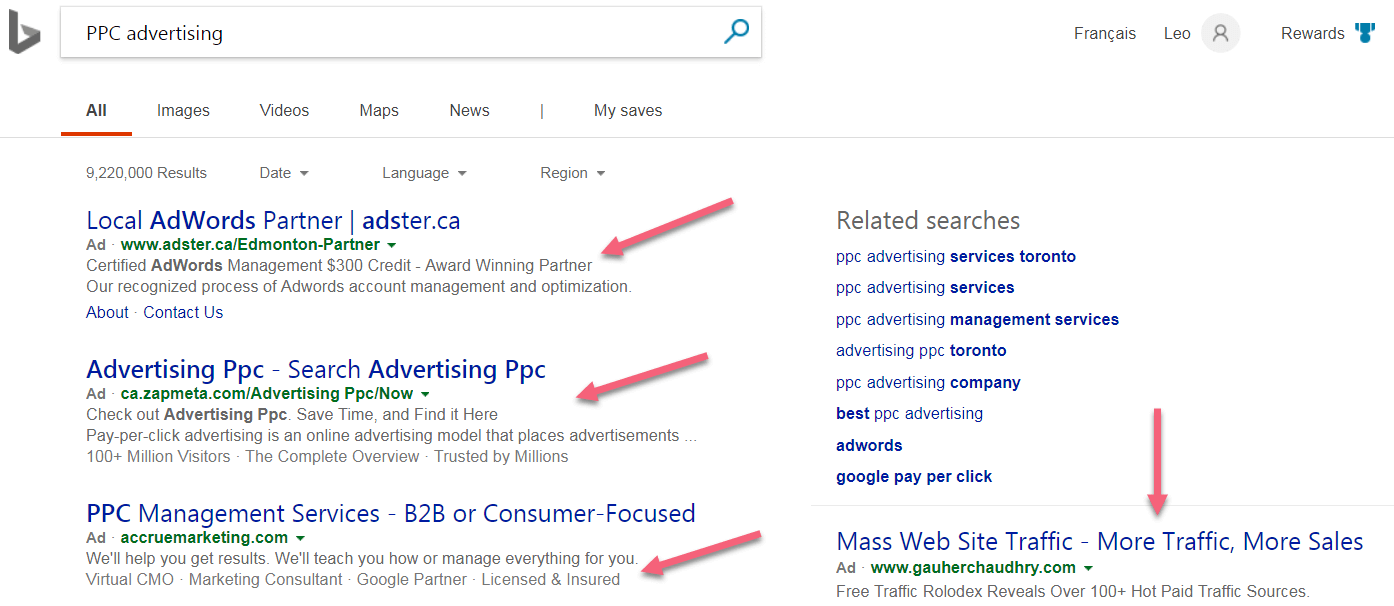
108) PNG
PNG stands for Portable Network Graphics. And are typically used to store graphics for web images.
109) Raw Click
A raw click can be the same visitor over and over again. So, for example, someone could click on your affiliate 5 times and that would be tabulated as 5 raw clicks.
110) Remarketing
Remarketing is a way of you reconnecting with a visitor to your website who hasn’t taken the desired action such as signing up for your newsletter, signing up for a service or buying a product.
Remarketing allows you as a marketer to target these visitors with new ads that will hopefully make them more likely to convert into a customer.
111) ROI
ROI stands for Return On Investment.
This is the calculation used for the return on your investment. For example, you spend $1000 on advertising and you make $1500 – your ROI is $500.
112) Sales Funnel
A Sales Funnel is also known as a Revenue Funnel. A sales funnel is a buying process that leads a person through a stepped sales process to buy a product.
Sales funnels can vary in their complexity; however, the main steps to a sales funnel are: Leads to Prospects to Customers.
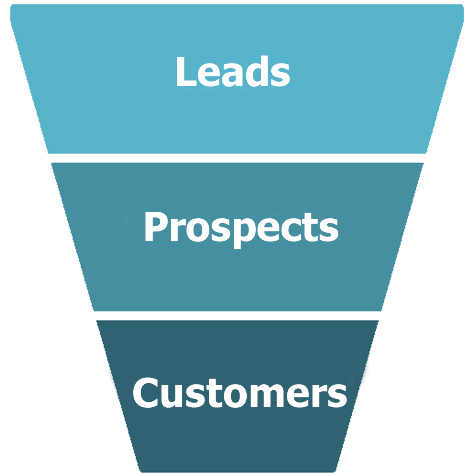
113) SaaS
SaaS stands for Software as a Service.
Examples of software as a service would be Aweber which provides the service for email marketing. Another example would be Shopify. Where they provide the platform where you can create an online store.
114) SEO
SEO stands for Search Engine Optimization.
This is where the search engines rank your website, your web pages, videos, and such based on what the search engines consider the most relevant to users. These are unpaid results, also known as organic.
115) SERP
SERP stands for Search Engine Results Page. These are the resulting pages shown when you do a search in a search engine.
116) Site Speed
Site speed is often confused with page speed. Page speed that’s the measurement of how fast your content loads. With site speed, this is how quickly your visitors can interact with your content.
117) Skyscraper Ad
This is an online ad that is tall and thin. Typically the dimensions for a skyscraper ad are 120 x 600px or 160 x 600px.
118) SMTP
SMTP stands for Simple Mail Transfer Protocol. This is the protocol to move email messages from the sender to the receiver.
119) Tag
A tag is a pre-defined term used to identify a post within WordPress. Unlike categories that are broad in nature. A tag is focused on specific topics. Tags are very useful as it allows a visitor to search for your post.
For example, you may have a category for Dog Training. You can add tags to be more specific such as: Housebreak, Potty Train.
So, this post is listed under the category Internet Marketing. And if you used my search tool and put in any one of these terms, I set in the tags option this post would appear.

120) ToFu
ToFu stands for Top Of Funnel. This is the beginning of a marketing (sales) funnel. Here a person is in the research phase and is looking for information and answers.
121) Unique Click
Unique clicks are the number of times that a link was clicked by an individual user. So, for example, if the same user clicked on your affiliate link 5 times it would only count as 1 unique visitor, not 5.
122) URL
URL stands for Uniform Resource Locator.
This is a website’s homepage address. My URL for my website is https.netwiseprofits.com.
123) UX
UX stands for User Experience.
The UX is how a visitor interacts with an app or website. So, this includes things like navigation of the site, the design, colors, usability, branding, function, etc.
Having a website that provides a good user experience is critical to having a successful online business.
124) Webinars
Webinars are online seminars. Webinars can be used for the marketing of products or services. They are also used for training.
125) Web Vitals
Web vitals are a specific set of factors that Google used to determine the best user experience people can have with a webpage (your website). These include the largest contentful paint, first input delay, and cumulative layout shift.
Largest contentful paint – this measures the time it takes for a visitor to see the largest element (content) on screen and is ready to interact with.
First input delay – this measures the time when a user (visitor) first interacts with your website.
Cumulative layout shift – this measures how much your content moves around while the web page is rendering. It’s measuring the stability of your page. If things move around a lot this does not provide a good user experience.
126) WordPress Dashboard
The WordPress dashboard is also known as the admin dashboard. And the WordPress dashboard is the control panel for your entire WordPress website.
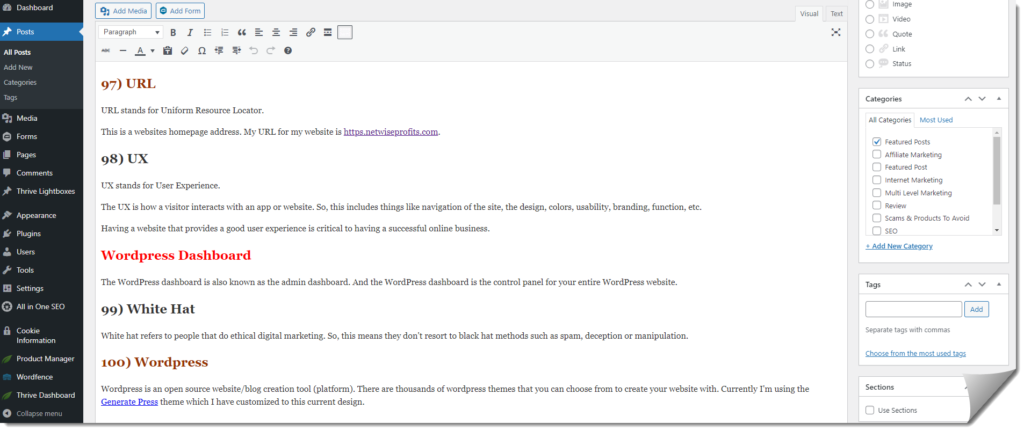
127) White Hat
White hat refers to people that do ethical digital marketing. So, this means they don’t resort to black hat methods such as spam, deception or manipulation.
128) WordPress
WordPress is an open-source website/blog creation tool (platform). There are thousands of WordPress themes that you can choose from to create your website with. Currently, I’m using the Generate Press theme which I have customized to this current design.
129) XML Sitemap
An XML sitemap is designed to help the search engine crawler bot easily find all the pages and posts of a website.
Ok That’s It
I hope you found this information helpful. If so, feel free to share it with your audience.
I’ll be adding to this list as time goes on. And if there’s a term you want me to add to this list leave your suggestion in the comments section below and I’ll be sure to add it.
And as always if you need a hand with anything you can email me anytime.
I believe in you!!
Leo

Hey it’s Leo. I’m the founder of Netwise Profits, and I’ve been making a full-time online income as an affiliate marketer since 2005. And as of 2012, I’ve been personally helping people turn their hobbies, passions, and interests into online incomes through affiliate marketing. And I can help you too.


